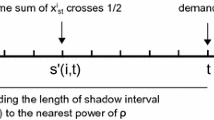Abstract
The capacitated Economic Order Quantity problem (capacitated EOQ) is a well-known problem where products have to be shipped between two points with a vehicle of given capacity. Each shipment has a fixed cost, independent of the shipped quantity, and an inventory cost is generated in the two points. The problem consists in finding the optimal time between consecutive shipments, which minimizes the total cost. The problem is a capacitated variant of the EOQ problem and has a closed form solution. Since such solution is often irrational, it is often rounded to an integer value. In this paper we investigate the errors which are generated by rounding procedures to integer and powers-of-two values. We show that, although in the worst case a tight general relative error of 2 is generated by all the considered rounding procedures, the procedure which rounds to the best between the lower and upper values (integer or powers-of-two) has a performance of \(\frac{1}{2}\)(\(\sqrt 2 + 1/\sqrt 2 \))≈1.06 on classes of instances of high practical relevance.
Similar content being viewed by others
References
D.E. Blumenfeld, L.D. Burns, J.D. Diltz and C.F. Daganzo, Analyzing trade-offs between transportation, inventory and production costs on freight networks, Transportation Research B 19 (1985) 361–380.
D. Erlenkotter, An early classic misplaced: Ford W. Harris's economic order quantity model of 1915, Management Science 35 (1989) 898–900.
B. Fleischmann, Transport and inventory planning with discrete shipment times, in: New Trends in Distribution Logistics, eds. M.G. Speranza and P. Staehly, Lecture Notes in Economics and Mathematical Systems, Vol. 480 (Springer, 1999) pp. 159-178.
R.W. Hall, Determining vehicle dispatch frequency when shipping frequency differs among suppliers, Transportation Research B 19 (1985) 421–431.
P.L. Jackson, W.L. Maxwell and J.A. Muckstadt, Determining optimal reorder intervals in capacitated production-distribution systems, Management Science 34 (1988) 938–958.
H.L. Lee and S. Nahmias, Single-product, single-location models, in: Handbooks in Operations Research and Management Science, Vol. 4, eds. S.C. Graves, A.H.G. Rinnooy Kan and P.H. Zipkin (North-Holland, 1993) pp. 3-55.
W.L.Maxwell and J.A.Muckstadt, Establishing consistent and realistic reorder intervals in production-distribution systems, Operations Research 33 (1985) 1316–1341.
J.A. Muckstadt and R.O. Roundy, Analysis of multistage production systems, in: Handbooks in Operations Research and Management Science, Vol. 4, eds. S.C. Graves, A.H.G. Rinnooy Kan and P.H. Zipkin (North-Holland, 1993) pp. 59-131.
M.G. Speranza and W. Ukovich, Minimizing transportation and inventory costs for several products on a single link, Operations Research 42 (1994) 879–894.
Author information
Authors and Affiliations
Rights and permissions
About this article
Cite this article
Bertazzi, L., Speranza, M.G. Rounding Procedures for the Discrete Version of the Capacitated Economic Order Quantity Problem. Annals of Operations Research 107, 33–49 (2001). https://doi.org/10.1023/A:1014986628929
Issue Date:
DOI: https://doi.org/10.1023/A:1014986628929




